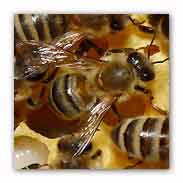Honeybees never cease to amaze us: their
bite contains a natural anesthetic. This discovery was made by a
team of Greek and Cypriot researchers, in collaboration with the
CNRS Laboratoire Evolution, Génomes et Spéciation.

In a study published in the journal PLoS
ONE, the researchers show that bites from domestic honeybees (Apis
mellifera) contain a compound, 2-heptanone (2-H), that acts as an
efficient natural anesthetic. This finding has been patented, so 2-H
can now be commercially produced as a local anesthetic, which offers
the additional advantage of low toxicity to humans and animals.
Several hypotheses have been made about the function of 2-heptanone
(2-H), a natural compound present in many foodstuffs and in insects,
but its anesthetic properties were previously unknown.
Results now show that 2-H, secreted by
honeybee mandible glands, can paralyze small arthropods bitten by
the bees, for up to nine minutes. Like a snake, a honeybee can use
its mandibles to bite a foe and secrete the substance into the
wound, paralyzing it. The bees can then throw the intruder out of
their nest. This approach is particularly efficient against
predators and parasites that are too small to be stung and killed
with venom. But this anesthetic, which helps honeybees repel pests
that attack their colonies – such as the wax moth Galleria
mellonella and parasitic mite Varroa destructor – also has enormous
potential in human medicine.
The researchers compared the anesthetic
properties of 2-H with those of lidocaine, one of the most widely
used anesthetics in the world. Effects of the two substances on wax
moth larvae and on an isolated rat sciatic nerve preparation showed
that their properties and mode of action were very similar: both
blocked particular sodium channels. Additionally, 2-heptanone
appeared to be even less toxic than lidocaine. Because 2-H has low
toxicity compared with classic anesthetics, this natural substance
is likely to find many applications in both human and veterinary
medicine.
For more information
The bite of the honeybee: 2-heptanone secreted from honeybee
mandibles during a bite acts as a local anesthetic in insects and
mammals, par Alexandros Papachristoforou, Alexia Kagiava,
Chrisovalantis Papaefthimiou, Aikaterini Termentzi, Nikolas
Fokialakis, Alexios-Leandros Skaltsounis, Max Watkins, Gérard
Arnold, George Theophilidis.
PLoS ONE 7(10): e47432. doi:10.1371/journal.pone.0047432
(MDN) |
![]()